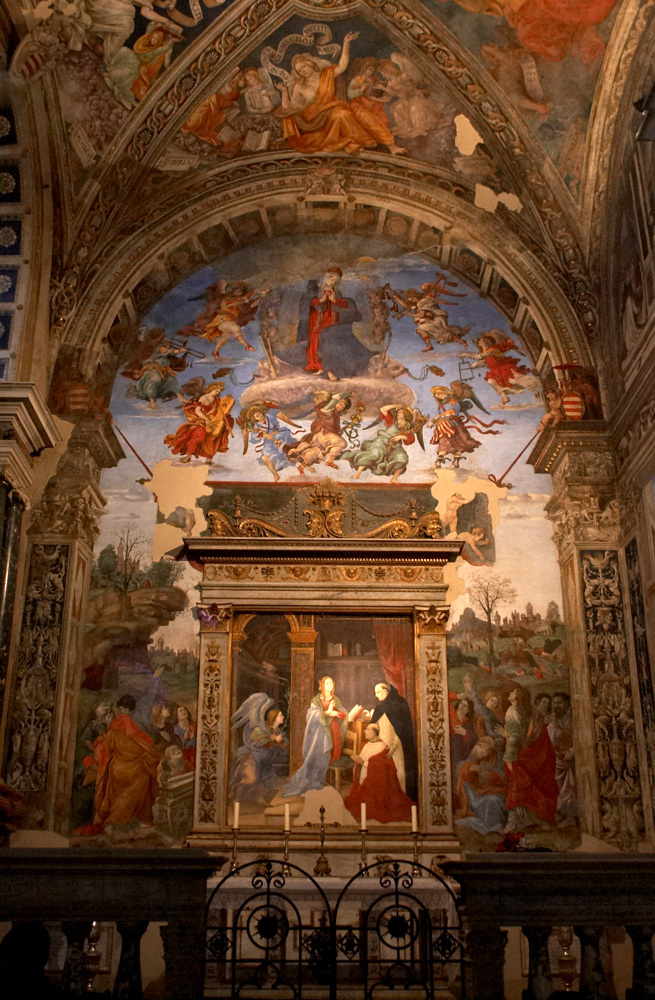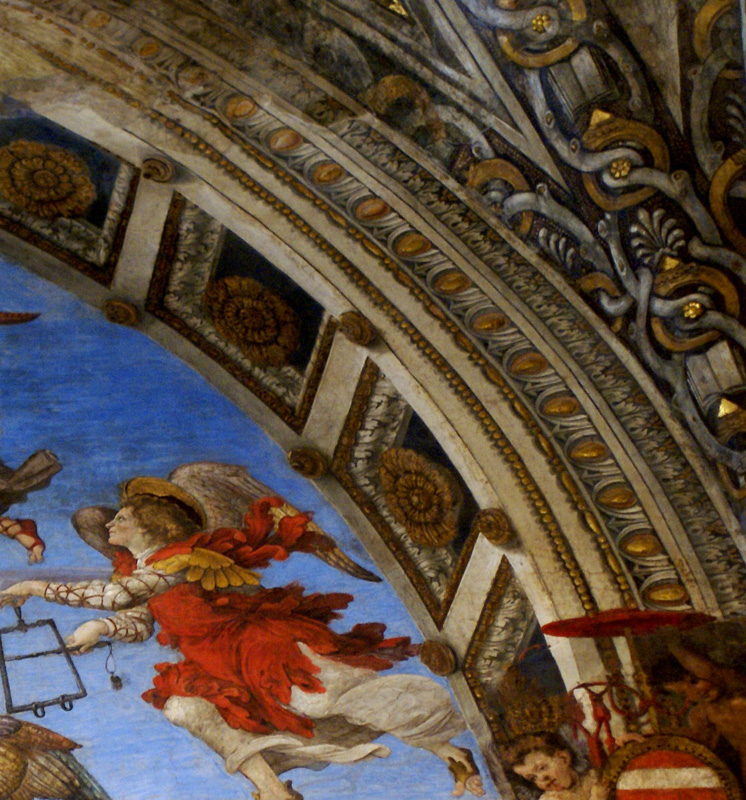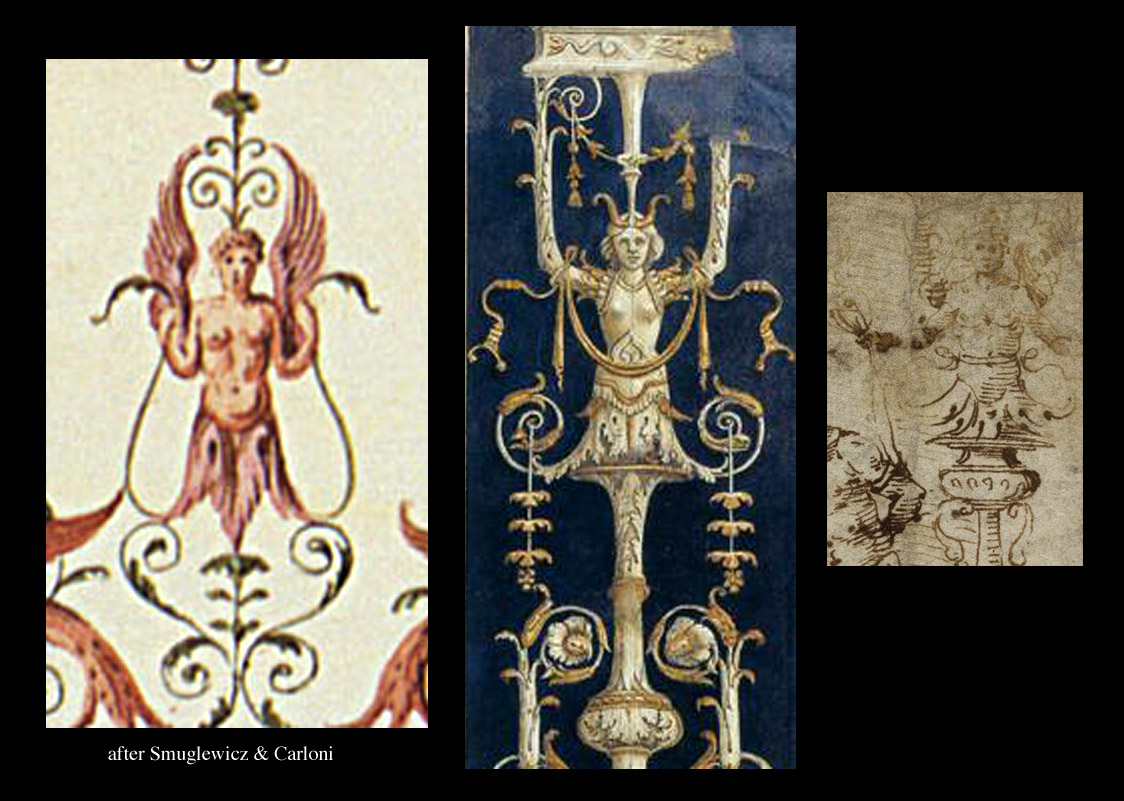



| Our search for the archetypal acanthus frieze has taken us on a fantastic journey, that brings us now to a fresco by Flippino Lippi. Executed in the Carafa Chapel of S. Maria sopra Minerva in Rome, by Lippi in 1489 to 1491. While I was searching for Renaissance examples of candelabra motifs, I found these amazing examples of Lippi which are more elaborate that most by far and there was an almost incidental acanthus frieze as well. This lead me to delve further into the story of Lippi and the beginnings of Grotesque Art. |


| Now after pouring through hundreds of web documents I have found some interesting links concerning Lippi and the discovery of the Golden House of Nero (the Domus Aurea). Using a kind of shotgun modus operandi I googled "Filippino Lippi domus" and the first thing that came up was a British Museum document concerning a drawing by Lippi, below I show this drawing as well as the "Curators Comments." |

|
Curator's comments "This drawing is similar to the grotteschi in the Golden House of Nero (the Domus Aurea) in Rome, but it appears to be Filippino's own invention rather than a copy of the Antique decorations. The motifs, especially the sphinx and the vase, are similar to those found in a drawing after Domus Aurea decorations in the Uffizi, Florence (1673 E; illustrated in G.R. Goldner and C.C. Bambach (eds.), exhib. cat., New York, Metropolitan Museum of Art, 'The Drawings of Filippino Lippi and His Circle', 1997, no. 60). As with the other grotteschi by Filippino, the present study probably dates from the late 1480s to early 1490s when the artist was at work on the Carafa chapel in Rome (executed between 1489-1493). The figure study on the verso has not been connected with any painting. For Lippi's drawings after the Antique see I.H. Shoemaker, 'Drawings after the Antique by Filippino Lippi', "Master Drawings", XVII, Spring 1978, pp. 35-43" Lit.: R. Schilling (ed.), 'Die von Edmund Schilling gesammelten Zeichnungen', 1982, no. 19, p. 157; J. K. Nelson, 'An Inventory of Drawings by Filippino Lippi and his Circle (With Two Additions)', in J.Garton and D. Wolfthal (eds), 'New Studies on Old Masters: Essays in Renaissance Art in Honour of Colin Eisler', Toronto, 2011, p. 196, fig. 10.2 |
| These comments seem not only contradictory but completely illogical considering, that it is well known that Lippi visited the Domus Aurea site and even engraved his signature into the walls along with signatures of many others, including Raphael and Michelangelo. |
|
"When a young Roman inadvertently fell through a cleft in the Esquiline hillside at the end of the 15th century, he found himself in a strange cave or grotta filled with painted figures. Soon the young artists of Rome were having themselves let down on boards knotted to ropes to see for themselves. The fourth style frescoes that were uncovered then have faded to pale gray stains on the plaster now, but the effect of these freshly rediscovered grottesche. decorations was electrifying in the early Renaissance, which was just arriving in Rome. When Pinturicchio, Raphael and Michelangelo crawled underground and were let down shafts to study them, carving their names on the walls to let the world know they had been there, the paintings were a revelation of the true world of antiquity. Beside the graffiti signatures of later tourists, like Casanova and the Marquis de Sade scratched into a fresco inches apart (British Archaeology June 1999), are the autographs of Domenico Ghirlandaio, Martin van Heemskerck, and Filippino Lippi*. *Romey, Kristin M. (July/August 2001). "The Rain in Rome". Archaeology (Archaeological Institute of America) 54 (4): 20. ISSN 0003-8113[17] |
|
However I want to go further in this line of thought because it may be that Lippi was profoundly moved by the amazing "new" art that he saw at Domus Aurea. You only have to look through the work of Lippy prior to his "transformation" indeed it is as though it was a kind of revelation, Lippy was not content to just copy the style and decorative details of these fourth style frescos as did Raphael and others, but rather, moved on to the next level, combing everything into a fantastic amalgam and producing what really has now become known as "grotteschi." Below I show another fresco by Lippy that is also found in the Carafa Chapel, here you will see in the details of his candelabra motifs a figure that is not too dissimilar to that of his drawing. |



|
*"In 1973, thanks to professor Stanislaw Lorentz's efforts, the National Museum in Warsaw bought in London a coloured portfolio Vestigia delle Terme di Tito. This set contains sixty large hand-coloured plates showing paintings from the basement of an ancient building taken for the Baths of Titus (Thermae Titi), which in fact were the ruins of Nero's Golden House (Domus Aurea). This great work of art was created by Vincenzo Brenna, a Roman architect (17451820), a Polish painter and draughtsman Franciszek Smuglewicz (17451807), and Marco Gregorio Carloni (17421786), a Roman engraver specialising in engravings of ancient monuments." (click here to see the complete article) Nero's Golden House Exhibition organized to commemorate the 200th death anniversary of Franciszek Smuglewicz. |